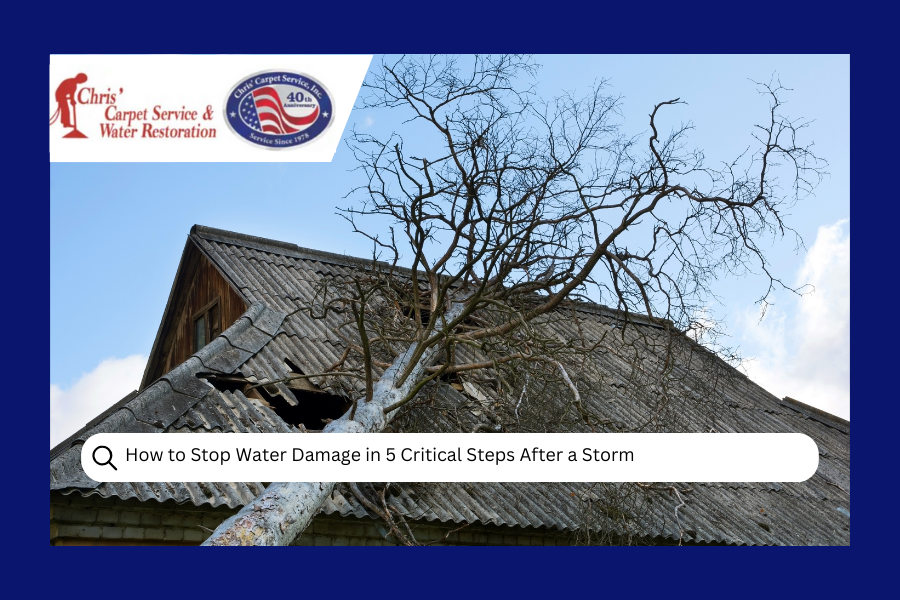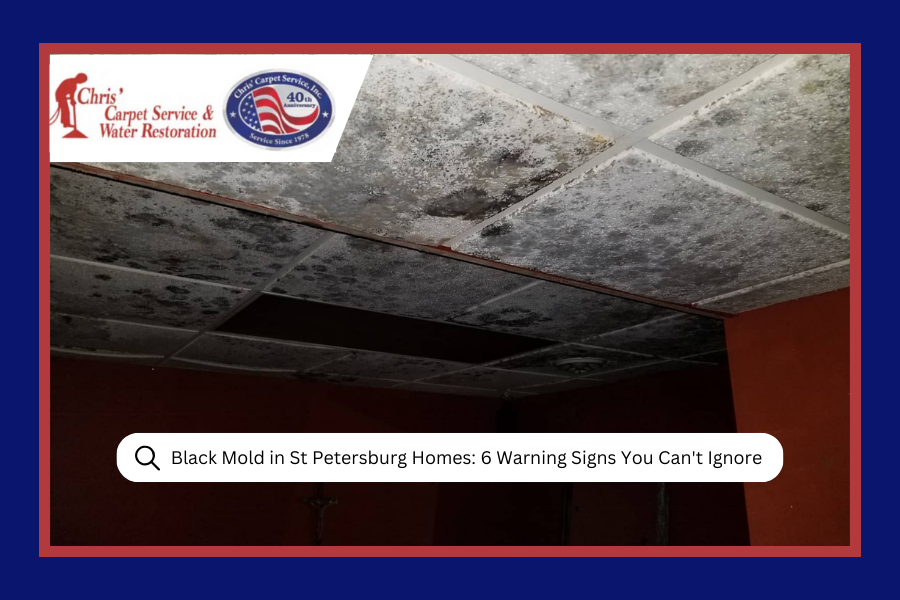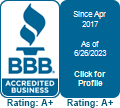How to Stop Water Damage in 5 Critical Steps After a Storm
Jump To:
Living in the Tampa Bay Area means we're no strangers to sudden storms that can turn a peaceful afternoon into a water damage nightmare. Whether it's a surprise downpour or one of those infamous Florida storms that seems to come out of nowhere, water has this sneaky way of finding every crack, crevice, and weakness in our homes.
We've seen it all at Chris' Carpet Service & Water Restoration, and trust us, the faster you act after water enters your home, the better your chances of minimizing damage and avoiding those dreaded mold problems down the road. So let's dive into the five critical steps that can save your home and your sanity when storm water decides to make itself at home.
🚨 Emergency Response Timeline 🚨
0-2 Hours
Safety Assessment & Stop Water Source
2-24 Hours
Water Removal & Initial Drying
24-48 Hours
Complete Drying & Professional Help
Step 1: Safety First - Assess the Situation Before You Act
Before you do anything else, take a deep breath and assess what you're dealing with. Water and electricity don't play nicely together, so if there's any standing water near electrical outlets, appliances, or your electrical panel, stay back and call a professional immediately.
Here's your quick safety checklist:
- Turn off electricity to affected areas if you can safely reach the breaker
- Check for structural damage like sagging ceilings or warped floors
- Identify the water source if it's still active
- Wear protective gear like rubber boots and gloves
- Document everything with photos for insurance purposes
If the water is from a sewage backup or contains contaminants, this isn't a DIY situation. Our team at Chris' Carpet Service & Water Restoration handles sewage backup damage regularly, and we know firsthand how dangerous contaminated water can be to your health.
⚠️ Need Immediate Help?
Don't wait until damage gets worse. Our 24/7 emergency team is standing by.
Contact Us NowStep 2: Stop the Source - Cut Off Water at Its Origin
This might seem obvious, but you'd be surprised how many people focus on cleaning up water while it's still pouring in. It's like trying to empty a bathtub with the faucet still running!
Common water sources after storms:
- Roof leaks from damaged shingles or flashing
- Overflowing gutters backing up into the house
- Windows and doors that aren't properly sealed
- Burst pipes from pressure changes
- Backed up floor drains
If you can safely stop the water source, do it. Turn off the main water supply if needed, move furniture away from active leaks, and use buckets or tarps to redirect water flow. Sometimes a temporary fix now can prevent thousands of dollars in additional damage.
Step 3: Remove Standing Water Quickly - Time Is Your Enemy
Here's the thing about water damage: it doesn't take a vacation. Every minute that water sits in your home, it's working its way deeper into materials, creating perfect conditions for mold growth and structural damage.
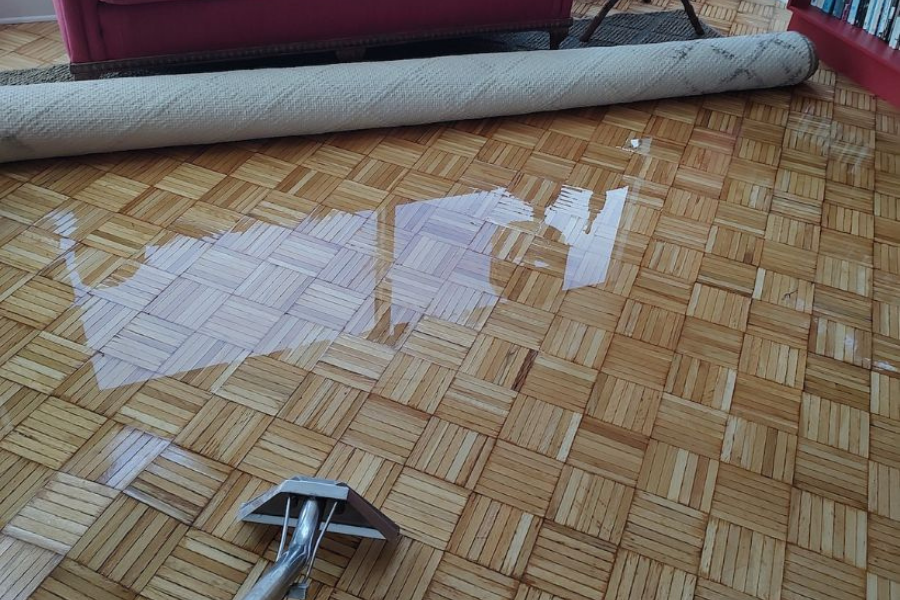
Professional water extraction equipment can remove large volumes of standing water much faster than household tools, preventing further damage to your home's structure and materials.
Your water removal game plan:
- Use a wet/dry vacuum for smaller amounts
- Mop and squeegee what you can manage
- Move furniture and belongings to dry areas
- Pull up soaked rugs and padding immediately
- Call professionals for large volumes of water
We always tell our Tampa Bay neighbors that if you're dealing with more than you can handle with household tools, it's time to bring in the pros. Our water damage restoration team at Chris' Carpet Service & Water Restoration has industrial-grade equipment that can extract water and moisture much faster than anything you'll find at the hardware store.
DIY vs. Professional Water Removal
| Method | Best For | Time Required | Effectiveness |
|---|---|---|---|
| Household Wet/Dry Vacuum | Small leaks, single rooms | 2-4 hours | Limited capacity |
| Mops & Towels | Surface water, cleanup | 4-8 hours | Labor intensive |
| Professional Extraction | Major flooding, multiple rooms | 1-3 hours | Complete removal |
Step 4: Start the Drying Process Immediately
Once you've removed the visible water, the race against hidden moisture begins. Water has this annoying habit of hiding in places you can't see, like behind walls, under flooring, and in insulation.
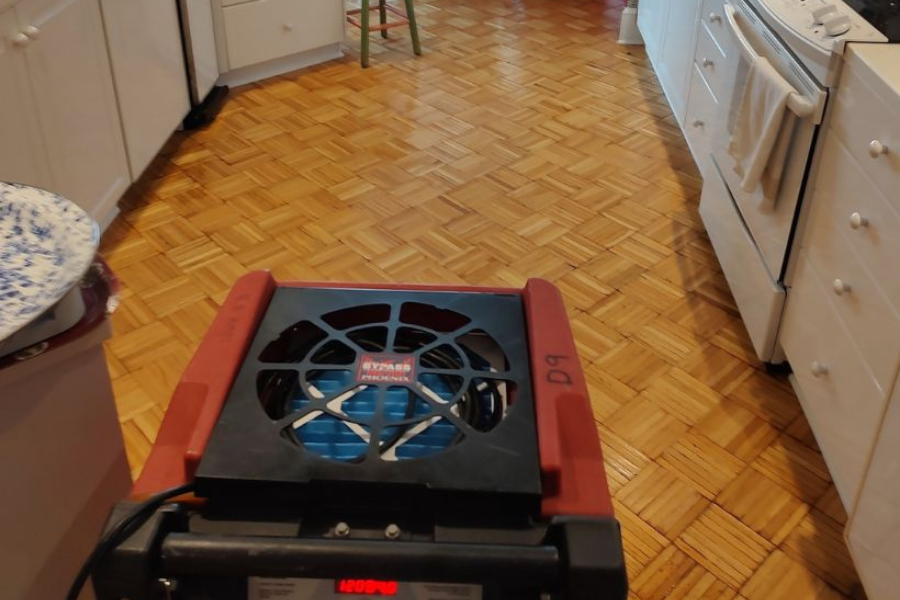
Professional drying equipment like industrial dehumidifiers and air movers can reduce drying time from weeks to just a few days, preventing mold growth and structural damage.
Get air moving with these tactics:
- Open windows and doors for cross ventilation (weather permitting)
- Set up fans to increase air circulation
- Use dehumidifiers to pull moisture from the air
- Remove wet materials like carpeting, padding, and damaged drywall
- Monitor humidity levels if you have a hygrometer
Professional tip from our years of experience at Chris' Carpet Service & Water Restoration: don't just focus on what you can see. Moisture trapped in wall cavities or under flooring can cause problems weeks or months later. That's why we use specialized moisture detection equipment to find hidden water that the naked eye can't spot.
Step 5: Document Everything and Call Your Insurance Company
We get it, paperwork is about as fun as watching paint dry. But proper documentation can make the difference between a covered claim and an out-of-pocket expense that makes your wallet cry.
Documentation essentials:
- Photos and videos of all damaged areas
- List of damaged items with approximate values
- Notes about when the damage occurred
- Receipts for any emergency supplies or services
- Contact information for any professionals you hire
Most insurance companies want to hear from you quickly after damage occurs. Don't wait weeks to file your claim. We at Chris' Carpet Service & Water Restoration work with insurance companies regularly and can help navigate the claims process if you need professional restoration services.
When to Call the Professionals
Look, we're all for DIY projects, but water damage restoration isn't the time to learn new skills. If you're dealing with more than a minor leak or if water has been standing for more than 24-48 hours, it's time to call in reinforcements.
Here's when you should definitely pick up the phone:
- Contaminated water from sewage or flooding
- Water affecting multiple rooms or floors
- Signs of electrical damage
- Structural concerns like sagging or warping
- Any amount of water in carpeted areas
We at Chris' Carpet Service & Water Restoration have been helping Tampa Bay area families deal with water emergencies since 1976, and we've learned that quick action saves money, stress, and sometimes entire homes. Our team is available 24/7 because water damage doesn't wait for business hours.
Preventing Future Storm Water Damage
While we can't control Florida's weather (wouldn't that be nice?), we can take steps to make our homes more resilient:
- Regular roof inspections: Catch small problems before they become big ones
- Gutter maintenance: Keep them clean and properly directed away from your foundation
- Window and door seals: Check and replace weatherstripping annually
- Landscape grading: Ensure water flows away from your home's foundation
- Emergency supplies: Keep tarps, buckets, and flashlights easily accessible
For comprehensive storm preparedness guidance, Ready.gov's flood safety information provides additional federal resources for protecting your home and family.
For more detailed prevention strategies, check out our guide on house water damage detection and learn about how washing machine leaks can cause costly damage that storms can make worse.
The Bottom Line
Water damage after a storm doesn't have to spell disaster for your home. By acting quickly, staying safe, and knowing when to call for help, you can minimize damage and get back to normal life faster. Remember, every situation is different, and when in doubt, it's better to err on the side of caution.
Living in places like Tampa , St. Pete, and Clearwater means we're all in this together when it comes to dealing with Florida's weather surprises. Whether you're dealing with a small leak or major flooding, don't hesitate to reach out for help when you need it.
Frequently Asked Questions
How long do I have to act after storm water enters my home before permanent damage occurs?
You have a critical 24-48 hour window before mold growth begins and materials start breaking down. In Florida's humid climate, this timeline can be even shorter. The CDC's mold cleanup guidelines emphasize this same timeline for preventing mold growth. The five steps outlined above should be started immediately after the storm passes and it's safe to assess damage.
What's the difference between storm water damage and regular plumbing leaks when it comes to cleanup?
Storm water often contains more contaminants from outside sources like dirt, debris, and potentially sewage if storm drains back up. This makes the cleanup more complex and often requires professional disinfection that goes beyond what's needed for clean water leaks from pipes.
Should I remove wet drywall myself after a storm, or wait for professionals?
If drywall has been wet for more than 48 hours or shows signs of significant damage like crumbling or dark staining, it's safer to have professionals handle removal. Wet drywall can harbor dangerous mold and becomes structurally unstable, making DIY removal potentially hazardous.
My carpet got soaked during the storm but seems dry now. Do I still need to worry about it?
Unfortunately, yes. Carpet padding underneath often stays wet much longer than the surface carpet, creating perfect conditions for mold growth and odors. Storm water also brings in contaminants that can remain in carpet fibers. Professional assessment is usually needed to determine if the carpet can be saved or needs replacement.
Ready to Get Professional Help?
For immediate water damage assistance in the Tampa Bay Area, contact Chris' Carpet Service & Water Restoration at (727) 888-5111. We're available 24/7 for emergency response and can help guide you through the entire restoration process.
Want to learn more about preventing water damage? Check out our blog post on dishwasher leaks as a hidden threat for additional insights that can help protect your home year-round.

